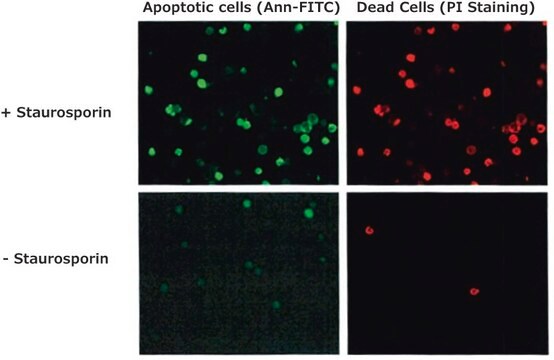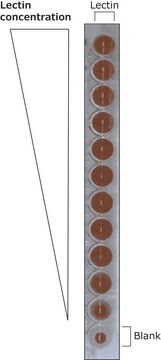A9460
Annexin V from human placenta
≥90% (SDS-PAGE), buffered aqueous solution
Synonyme(s) :
Annexin V, Calphosbindin I, Lipocortin V, PAP-1
About This Item
Produits recommandés
Source biologique
human placenta
Niveau de qualité
Essai
≥90% (SDS-PAGE)
Forme
buffered aqueous solution
Poids mol.
33 kDa (four subunits)
Technique(s)
cell based assay: suitable
Impuretés
Human Source(HCV), tested negative
Solubilité
water: soluble
Adéquation
suitable for molecular biology
Numéro d'accès UniProt
Conditions d'expédition
dry ice
Température de stockage
−70°C
Informations sur le gène
human ... ANXA5(308)
Vous recherchez des produits similaires ? Visite Guide de comparaison des produits
Description générale
Annexin V is a calcium-dependent phospholipid-binding protein. It is expressed in high concentration in cells with barrier functions, such as vascular endothelium, epithelial cells in bile ducts, placental trophoblasts, mammary ducts, renal tubules, and nasal epithelium.
Application
- to verify the involvement of phosphatidylserine in adhesion using flow cytometry
- to test adhesion specificity of phosphatidylserine
- for synthesis of NIR700-Annexin-V imaging probe
- in dynamic light scattering (DLS) assay to test the effects of various treatments on virion aggregation
Actions biochimiques/physiologiques
Conditionnement
Forme physique
Code de la classe de stockage
12 - Non Combustible Liquids
Classe de danger pour l'eau (WGK)
WGK 2
Point d'éclair (°F)
Not applicable
Point d'éclair (°C)
Not applicable
Faites votre choix parmi les versions les plus récentes :
Déjà en possession de ce produit ?
Retrouvez la documentation relative aux produits que vous avez récemment achetés dans la Bibliothèque de documents.
Les clients ont également consulté
Notre équipe de scientifiques dispose d'une expérience dans tous les secteurs de la recherche, notamment en sciences de la vie, science des matériaux, synthèse chimique, chromatographie, analyse et dans de nombreux autres domaines..
Contacter notre Service technique





